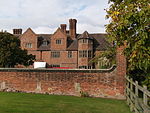Bishops Wood
Bishops Wood, or Bishopswood (grid reference SJ835097) is a small village on the Staffordshire border with Shropshire. It is home to the Royal Oak public house, the first to be named after the nearby oak tree at Boscobel House in which King Charles II hid after the Battle of Worcester. The population for this village taken at the 2011 census can be found under Brewood and Coven. Bishop's Wood (grid reference SJ753310) is a 352 hectare wood 4 miles west north west of Eccleshall, Staffordshire. The village, in the parish of Brewood, may derive its name from the country residence of the early Bishops of Lichfield: Boscobel House. The King Charles II Royal Oak tree, White Ladies Priory, Blackladies (another former priory, now a private residence) and Weston Park are all within easy walking distance.
Excerpt from the Wikipedia article Bishops Wood (License: CC BY-SA 3.0, Authors).Bishops Wood
Old Coach Road, South Staffordshire Brewood and Coven
Geographical coordinates (GPS) Address Nearby Places Show on map
Geographical coordinates (GPS)
| Latitude | Longitude |
|---|---|
| N 52.68259 ° | E -2.2402 ° |
Address
Old Coach Road
Old Coach Road
ST19 9AD South Staffordshire, Brewood and Coven
England, United Kingdom
Open on Google Maps











